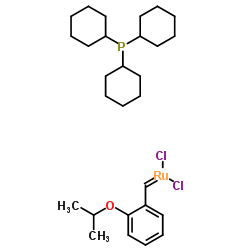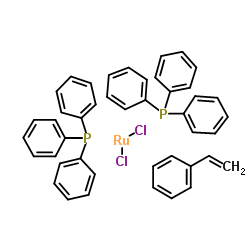DICHLORO(O-ISOPROPOXYPHENYLMETHYLENE)(TRICYCLOHEXYLPHOSPHINE)RUTHENIUM(II)

DICHLORO(O-ISOPROPOXYPHENYLMETHYLENE)(TRICYCLOHEXYLPHOSPHINE)RUTHENIUM(II) structure
|
Common Name | DICHLORO(O-ISOPROPOXYPHENYLMETHYLENE)(TRICYCLOHEXYLPHOSPHINE)RUTHENIUM(II) | ||
|---|---|---|---|---|
| CAS Number | 203714-71-0 | Molecular Weight | 600.606 | |
| Density | N/A | Boiling Point | 383.4ºC at 760 mmHg | |
| Molecular Formula | C28H45Cl2OPRu | Melting Point | 195-197ºC(lit.) | |
| MSDS | Chinese USA | Flash Point | 195.6ºC | |
| Symbol |

GHS02 |
Signal Word | Warning | |
| Name | dichloro-[(2-propan-2-yloxyphenyl)methylidene]ruthenium,tricyclohexylphosphane |
|---|---|
| Synonym | More Synonyms |
| Boiling Point | 383.4ºC at 760 mmHg |
|---|---|
| Melting Point | 195-197ºC(lit.) |
| Molecular Formula | C28H45Cl2OPRu |
| Molecular Weight | 600.606 |
| Flash Point | 195.6ºC |
| Exact Mass | 600.162903 |
| PSA | 22.82000 |
| LogP | 10.01880 |
| Vapour Pressure | 9.7E-06mmHg at 25°C |
| InChIKey | KMKCJXPECJFQPQ-UHFFFAOYSA-L |
| SMILES | C1CCC(P(C2CCCCC2)C2CCCCC2)CC1.CC(C)Oc1ccccc1C=[Ru](Cl)Cl |
| Storage condition | 2~8°C |
|
Section1. IDENTIFICATION OF THE SUBSTANCE/MIXTURE Product identifiers Product name: Hoveyda-Grubbs Catalyst 1st Generation CAS-No.: 203714-71-0 Relevant identified uses of the substance or mixture and uses advised against Identified uses: Laboratory chemicals, Manufacture of substances Section2. HAZARDS IDENTIFICATION Classification of the substance or mixture Classification according to Regulation (EC) No 1272/2008 [EU-GHS/CLP] Flammable solids (Category 2) Classification according to EU Directives 67/548/EEC or 1999/45/EC Highly flammable. Label elements Labelling according Regulation (EC) No 1272/2008 [CLP] Pictogram Signal wordWarning Hazard statement(s) H228Flammable solid Precautionary statement(s) P210Keep away from heat/sparks/open flames/hot surfaces. - No smoking. Supplemental Hazardnone Statements According to European Directive 67/548/EEC as amended. Hazard symbol(s) R-phrase(s) R11Highly flammable. S-phrase(s)none Other hazards - none Section3. COMPOSITION/INFORMATION ON INGREDIENTS Substances Synonyms: Dichloro(o- isopropoxyphenylmethylene)(tricyclohexylphosphine)ruthenium(II) Formula: C28H45Cl2OPRu Molecular Weight: 600,61 g/mol ComponentConcentration Dichloro(o-isopropoxyphenylmethylene)(tricyclohexylphosphine)ruthenium(II) CAS-No.203714-71-0- Section4. FIRST AID MEASURES Description of first aid measures General advice Consult a physician. Show this safety data sheet to the doctor in attendance. If inhaled If breathed in, move person into fresh air. If not breathing, give artificial respiration. Consult a physician. In case of skin contact Wash off with soap and plenty of water. Consult a physician. In case of eye contact Flush eyes with water as a precaution. If swallowed Do NOT induce vomiting. Never give anything by mouth to an unconscious person. Rinse mouth with water. Consult a physician. Most important symptoms and effects, both acute and delayed To the best of our knowledge, the chemical, physical, and toxicological properties have not been thoroughly investigated. Indication of any immediate medical attention and special treatment needed no data available Section5. FIRE-FIGHTING MEASURES Extinguishing media Suitable extinguishing media Use water spray, alcohol-resistant foam, dry chemical or carbon dioxide. Special hazards arising from the substance or mixture Carbon oxides, Oxides of phosphorus, Hydrogen chloride gas, Ruthenium oxide Advice for firefighters Wear self contained breathing apparatus for fire fighting if necessary. Further information Use water spray to cool unopened containers. Section6. ACCIDENTAL RELEASE MEASURES Personal precautions, protective equipment and emergency procedures Avoid dust formation. Avoid breathing vapors, mist or gas. Ensure adequate ventilation. Remove all sources of ignition. Evacuate personnel to safe areas. Environmental precautions Prevent further leakage or spillage if safe to do so. Do not let product enter drains. Methods and materials for containment and cleaning up Sweep up and shovel. Contain spillage, and then collect with an electrically protected vacuum cleaner or by wet-brushing and place in container for disposal according to local regulations (see section 13). Keep in suitable, closed containers for disposal. Contain spillage, pick up with an electrically protected vacuum cleaner or by wet-brushing and transfer to a container for disposal according to local regulations (see section 13). Reference to other sections For disposal see section 13. Section7. HANDLING AND STORAGE Precautions for safe handling Avoid formation of dust and aerosols. Provide appropriate exhaust ventilation at places where dust is formed.Keep away from sources of ignition - No smoking.Take measures to prevent the build up of electrostatic charge. Conditions for safe storage, including any incompatibilities Store in cool place. Keep container tightly closed in a dry and well-ventilated place. Recommended storage temperature: 2 - 8 °C Handle and store under inert gas. Light sensitive. Air sensitive. Specific end uses no data available Section8. EXPOSURE CONTROLS/PERSONAL PROTECTION Control parameters Components with workplace control parameters Exposure controls Appropriate engineering controls Handle in accordance with good industrial hygiene and safety practice. Wash hands before breaks and at the end of workday. Personal protective equipment Eye/face protection Safety glasses with side-shields conforming to EN166 Use equipment for eye protection tested and approved under appropriate government standards such as NIOSH (US) or EN 166(EU). Skin protection The selected protective gloves have to satisfy the specifications of EU Directive 89/686/EEC and the standard EN 374 derived from it. Handle with gloves. Gloves must be inspected prior to use. Use proper glove removal technique (without touching glove's outer surface) to avoid skin contact with this product. Dispose of contaminated gloves after use in accordance with applicable laws and good laboratory practices. Wash and dry hands. Body Protection Flame retardant antistatic protective clothing, The type of protective equipment must be selected according to the concentration and amount of the dangerous substance at the specific workplace. Respiratory protection Where risk assessment shows air-purifying respirators are appropriate use a full-face particle respirator type N100 (US) or type P3 (EN 143) respirator cartridges as a backup to engineering controls. If the respirator is the sole means of protection, use a full-face supplied air respirator. Use respirators and components tested and approved under appropriate government standards such as NIOSH (US) or CEN (EU). Section9. PHYSICAL AND CHEMICAL PROPERTIES Information on basic physical and chemical properties a) AppearanceForm: solid Colour: brown b) Odourno data available c) Odour Thresholdno data available d) pHno data available e) Melting point/freezingMelting point/range: 195 - 197 °C - lit. point f) Initial boiling point and no data available boiling range g) Flash pointno data available h) Evaporation rateno data available i) Flammability (solid, gas) The substance or mixture is a flammable solid with the subcategory 2. j) Upper/lowerno data available flammability or explosive limits k) Vapour pressureno data available l) Vapour densityno data available m) Relative densityno data available n) Water solubilityno data available o) Partition coefficient: n- no data available octanol/water p) Autoignitionno data available temperature q) Decompositionno data available temperature r) Viscosityno data available s) Explosive propertiesno data available t) Oxidizing propertiesno data available Other safety information no data available Section10. STABILITY AND REACTIVITY Reactivity no data available Chemical stability no data available Possibility of hazardous reactions no data available Conditions to avoid Heat, flames and sparks. Extremes of temperature and direct sunlight. Incompatible materials Strong oxidizing agents, acids, Bases Hazardous decomposition products Other decomposition products - no data available Section11. TOXICOLOGICAL INFORMATION Information on toxicological effects Acute toxicity no data available Skin corrosion/irritation no data available Serious eye damage/eye irritation no data available Respiratory or skin sensitization no data available Germ cell mutagenicity no data available Carcinogenicity IARC:No component of this product present at levels greater than or equal to 0.1% is identified as probable, possible or confirmed human carcinogen by IARC. Reproductive toxicity no data available Specific target organ toxicity - single exposure no data available Specific target organ toxicity - repeated exposure no data available Aspiration hazard no data available Potential health effects InhalationMay be harmful if inhaled. May cause respiratory tract irritation. IngestionMay be harmful if swallowed. SkinMay be harmful if absorbed through skin. May cause skin irritation. EyesMay cause eye irritation. Signs and Symptoms of Exposure To the best of our knowledge, the chemical, physical, and toxicological properties have not been thoroughly investigated. Additional Information RTECS: Not available Section12. ECOLOGICAL INFORMATION Toxicity no data available Persistence and degradability no data available Bioaccumulative potential no data available Mobility in soil no data available Results of PBT and vPvB assessment no data available Other adverse effects no data available Section13. DISPOSAL CONSIDERATIONS Waste treatment methods Product Burn in a chemical incinerator equipped with an afterburner and scrubber but exert extra care in igniting as this material is highly flammable. Offer surplus and non-recyclable solutions to a licensed disposal company. Contaminated packaging Dispose of as unused product. Section14. TRANSPORT INFORMATION UN number ADR/RID: 1325IMDG: 1325IATA: 1325 UN proper shipping name ADR/RID: FLAMMABLE SOLID, ORGANIC, N.O.S. (Dichloro(o- isopropoxyphenylmethylene)(tricyclohexylphosphine)ruthenium(II)) IMDG: FLAMMABLE SOLID, ORGANIC, N.O.S. (Dichloro(o- isopropoxyphenylmethylene)(tricyclohexylphosphine)ruthenium(II)) IATA:Flammable solid, organic, n.o.s. (Dichloro(o- isopropoxyphenylmethylene)(tricyclohexylphosphine)ruthenium(II)) Transport hazard class(es) ADR/RID: 4.1IMDG: 4.1IATA: 4.1 Packaging group ADR/RID: IIIMDG: IIIATA: II Environmental hazards ADR/RID: noIMDG Marine pollutant: noIATA: no Special precautions for user no data available Section15. REGULATORY INFORMATION This safety datasheet complies with the requirements of Regulation (EC) No. 1907/2006. Safety, health and environmental regulations/legislation specific for the substance or mixture no data available Chemical Safety Assessment no data available Section16. OTHER INFORMATION Further information Copyright 2011 Co. License granted to make unlimited paper copies for internal use only. The above information is believed to be correct but does not purport to be all inclusive and shall be used only as a guide. The information in this document is based on the present state of our knowledge and is applicable to the product with regard to appropriate safety precautions. It does not represent any guarantee of the properties of the product. Co., shall not be held liable for any damage resulting from handling or from contact with the above product. See reverse side of invoice or packing slip for additional terms and conditions of sale. |
| Precursor 2 | |
|---|---|
| DownStream 0 | |
|
Ruthenium-based heterocyclic carbene-coordinated olefin metathesis catalysts.
Chem. Rev. 110 , 1746, (2010)
|
|
|
Olefin Metathesis and Beyond A list of abbreviations can be found at the end of this article.
Angew. Chem. Int. Ed. Engl. 39 , 3012, (2000) The advent of well-defined catalysts for olefin metathesis which combine high activity, durability, and excellent tolerance towards polar functional groups has revolutionized the field. The past decad... |
|
|
The development of L2X2Ru=CHR olefin metathesis catalysts: an organometallic success story.
Acc. Chem. Res. 34 , 18, (2001) In recent years, the olefin metathesis reaction has attracted widespread attention as a versatile carbon-carbon bond-forming method. Many new applications have become possible because of major advance... |
| Dichloro(o-isopropoxyphenylmethylene)(tricyclohexylphosphine)ruthenium(II) |
| Dichloro(2-isopropoxyphenylmethylene)(tricyclohexylphosphine)ruthenium (II) |
| Hoveyda-Grubbs Catalyst 1st Generation |
| Hoveyda-Grubbs first generation catalyst |
| Phosphine, tricyclohexyl-, compd. with dichloro[[2-(1-methylethoxy)phenyl]methylene]ruthenium (1:1) |
| Dichloro(2-isopropoxybenzylidene)ruthenium - tricyclohexylphosphine (1:1) |
| MFCD03453042 |
| dichloro(tricyclohexylphosphine)-(o-isopropoxy-phenylmethylene)ruthenium(II) |
 CAS#:172222-30-9
CAS#:172222-30-9 CAS#:67191-35-9
CAS#:67191-35-9
